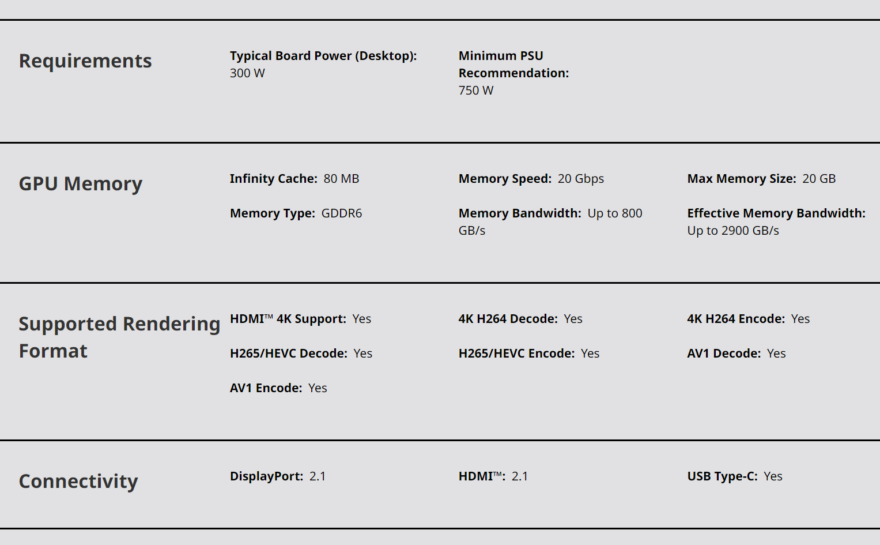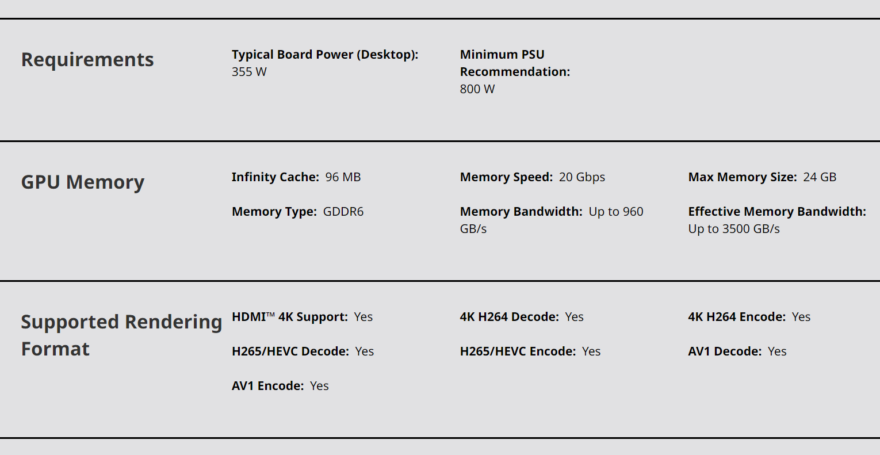AMD Radeon RX 7900 XT & 7900 XTX Review
Peter Donnell / 2 years ago
Chiplet Design
So with this new chiplet design and the way that the GPU is made up of different components, taking a look at the GPU size isn’t as clear cut, as it differs slightly with both the 7900 XT and XTX both incorporating a die size of 306mm² while the full size is larger at 495.5mm² on the 7900 XT and 533mm² on the 7900 XTX, though both include the same 58 billion transistors which is a little over double what the 6900 and 6950 XT had, which is pretty impressive on paper, especially considering that the RTX 4080 comes in 12 billion less transistors, though that is like comparing apples to oranges, as it’s completely different technologies and there’s a lot more to consider when comparing them.
AMD Radeon
When looking at the main specs, it’s a hard one to analyse, because you could compare it to the RTX 4080, which I think is where AMD are hoping to take a lot of customers from, but also to the last generation 6900 series, because both of these cards could be argued as the natural successor path to them, especially as the 7900 XTX is keeping the same $999 price tag that the 6950 XT launched with, while the 7900 XT is coming in a little cheaper at $899 at launch.
7900 XT
So starting with the 7900 XT, which comes in with 84 compute units and the same amount of ray accelerators, which is only 4 more than the 6900 XT, but again, new architecture, apples and oranges and all that. The shading units have seen a bump of around 5% now sporting 5376, and the same for the texture mapping units, now at 336 and a 50% increase in the ROPs or render output units.
7900 XTX
The 7900 XTX however has seen much larger bumps, now with 96 compute units and ray accelerators, 6144 shading units, 384 texture mapping units and the same 192 ROPs as the 7900 XT.
Where things get a bit more interesting is the different clock speeds that each card has with the 7900 XT coming in with a base clock of 1500MHz, a game clock of 2025MHz and a boost clock of 2394MHz while the 7900 XTX takes it a lot further with a much higher 1900MHz base clock, 2269MHz game clock and a whopping 2499MHz boost clock though if the Radeon RX 6500 XT has taught us anything, it’s that having the fastest clocks in a gaming card means very little as it’s almost like confusing your rev counter with your speedometer. VTEC kicked in yo!
AMD has also increased the memory clock speed on both cards from 2000MHz or 16 Gbps Effective on the 6900 XT, and 2250MHz or 18 Gbps Effective on the 6950 XT to 2500MHz or 20 Gbps Effective on both the 7900 XT and XTX so, we have a little bit more headroom there as well.
Now AMD has always had strong performance on the top-tier last-generation cards when it comes to pure rasterisation, and as we know, a lot of games are geared more toward AMD technologies, while other titles clearly favour NVIDIA, so a lot of that comes down to what games you play, and what games you don’t play as to what could be the better choice for you. The place that they’ve generally fallen behind is in Ray Tracing performance, which we will look at a little later on, as based on what we’ve been told and shown, they do believe they’ve upped their game here too, which is arguably the area that they lacked the most in.
Knowing that they can’t compete in certain areas, AMD has taken the approach of offering up the very best efficiency when it comes to power, especially when compared to the competition from NVIDIA and this is done through a few ways. Firstly, AMD has opted to use GGDR6 memory, as opposed to GDDR6X which would generate less heat overall, and coupled with what’s been done by utilising the chiplet based design, they’ve managed to make each card extremely efficient compared to the 40 series, with the 7900 XT rated at 300 Watts, while the 7900 XTX comes in a slightly higher 355 Watts, which is still dramatically less when looking at both the RTX 4080 and 4090.

As you can see, both of these cards are similarly equipped, with the XT featuring 84 Compute Units, while the XTX has 96, not a huge increase, but enough to make a noticeable difference. The XTX has 768 more Stream Processors than the XT, and delivers a much higher game Game and Boost frequency. Furthermore, the XTX has 24GB of GDDR6 memory, while the XT has to “make do” with just 20GB. I certainly don’t expect either card to be slow in the grand scheme of things, and both should cope pretty well with high-resolution gaming. In all fairness, for success, I don’t even think they need to beat the RTX 4080 in terms of performance, so long as they can get close-ish, and keep the price lower, it should prove a big success for AMD.
AMD Radeon RX 7900 XT
- Compute Units: 84
- Ray Accelerators: 84
- Game Frequency: 2000 MHz
- Boost Frequency: 2400 MHz
- Stream Processors: 5376
- Transistor Count: 58 Billion
- Shader Engines: 6
- TBP: 300W
- Memory Size: 20GB

Supported Features
- AMD Software: Adrenalin Edition
- AMD FidelityFX™ Super Resolution
- AMD Link
- AMD Noise Suppression
- AMD Radeon™ Super Resolution
- AMD Smart Access Memory
- VSR (4K)
- AMD Privacy View
- AMD Radeon™ Boost
- AMD Radeon™ Anti-Lag
- AMD Radeon™ Image Sharpening
- AMD Enhanced Sync Technology
- AMD FreeSync™ Technology
- AMD Radeon™ Chill
- TrueAudio Next
- The Vulkan® API
- AMD Mantle API
AMD Radeon RX 7900 XTX
- Compute Units: 96
- Ray Accelerators: 96
- Game Frequency: 2300 MHz
- Boost Frequency: 2500 MHz
- Stream Processors: 6144
- Transistor Count: 58 Billion
- Shader Engines: 6
- TBP: 355W
- Memory Size: 24GB

Supported Features
- AMD Software: Adrenalin Edition
- AMD FidelityFX™ Super Resolution
- AMD Link
- AMD Noise Suppression
- AMD Radeon™ Super Resolution
- AMD Smart Access Memory
- VSR (4K)
- AMD Privacy View
- AMD Radeon™ Boost
- AMD Radeon™ Anti-Lag
- AMD Radeon™ Image Sharpening
- AMD Enhanced Sync Technology
- AMD FreeSync™ Technology
- AMD Radeon™ Chill
- TrueAudio Next
- The Vulkan® API
- AMD Mantle API



















